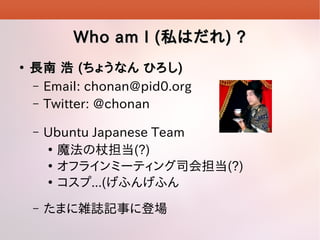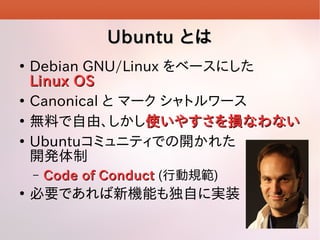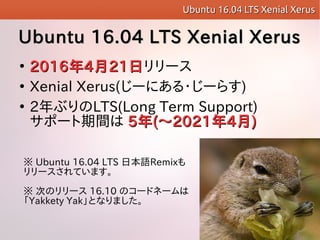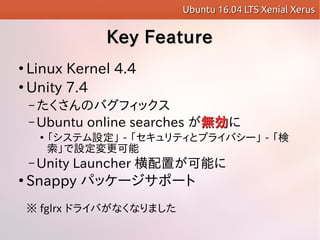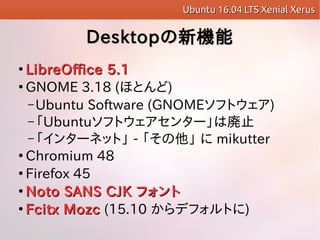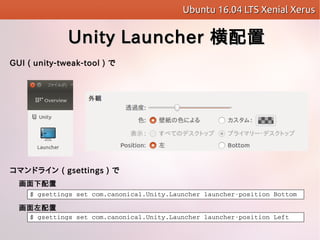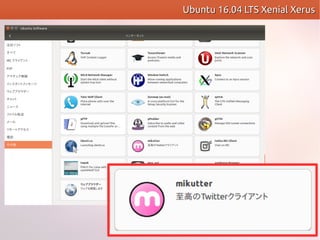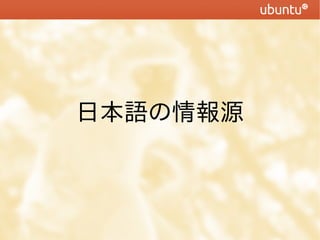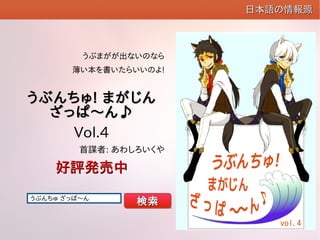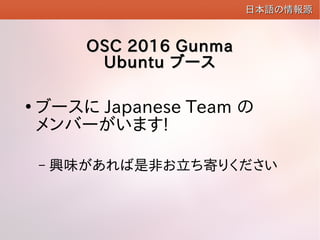リリースされたばかりの『Ubuntu 16.04LTS』のすべて
- 1. リリースされたばかりのリリースされたばかりの 『『Ubuntu 16.04LTSUbuntu 16.04LTS』』 のすべてのすべて 2016/05/14 13:00 枠 パート3 オープンソースカンファレンス2016 Gunma 於: LABI1 高崎 4F イベントホール 担当: 長南 浩 ( Ubuntu Japanese Team )
- 2. Who am I (Who am I (私はだれ私はだれ) ?) ? ● 長南 浩長南 浩 ((ちょうなん ひろしちょうなん ひろし)) – Email: chonan@pid0.org – Twitter: @chonan – Ubuntu Japanese Team ● 魔法の杖担当(?) ● オフラインミーティング司会担当(?) ● コスプ...(げふんげふん – たまに雑誌記事に登場
- 3. UbuntuUbuntu とはとは ● Debian GNU/Linux をベースにした Linux OSLinux OS ● Canonical と マーク シャトルワース ● 無料で自由、しかし使いやすさを損なわない使いやすさを損なわない ● Ubuntuコミュニティでの開かれた 開発体制 – Code of ConductCode of Conduct (行動規範) ● 必要であれば新機能も独自に実装
- 4. Ubuntu 16.04 LTS Xenial XerusUbuntu 16.04 LTS Xenial Xerus ● 20162016年年44月月2121日日リリース ● Xenial Xerus(じーにある?じーらす) ● 2年ぶりのLTS(Long Term Support) サポート期間は 55年年((??20212021年年44月月)) Ubuntu 16.04 LTS Xenial XerusUbuntu 16.04 LTS Xenial Xerus ※ Ubuntu 16.04 LTS 日本語Remixも リリースされています。 ※ 次のリリース 16.10 のコードネームは 「Yakkety Yak」となりました。
- 5. 16.04 LTS16.04 LTS のサポート期間のサポート期間 Ubuntu 16.04 LTS Xenial XerusUbuntu 16.04 LTS Xenial Xerus 安定したサポートを求めるなら断然 LTS
- 6. Key FeatureKey Feature ● Linux Kernel 4.4 ● Unity 7.4 – たくさんのバグフィックス – Ubuntu online searches が無効無効に ● 「システム設定」 - 「セキュリティとプライバシー」 - 「検 索」で設定変更可能 – Unity Launcher 横配置が可能に ● Snappy パッケージサポート ※ fglrx ドライバがなくなりました Ubuntu 16.04 LTS Xenial XerusUbuntu 16.04 LTS Xenial Xerus
- 7. DesktopDesktopの新機能の新機能 ● LibreOffice 5.1LibreOffice 5.1 ● GNOME 3.18 (ほとんど) – Ubuntu Software (GNOMEソフトウェア) – 「Ubuntuソフトウェアセンター」は廃止 – 「インターネット」 - 「その他」 に mikutter ● Chromium 48 ● Firefox 45 ● Noto SANS CJKNoto SANS CJK フォントフォント ● Fcitx MozcFcitx Mozc (15.10 からデフォルトに) Ubuntu 16.04 LTS Xenial XerusUbuntu 16.04 LTS Xenial Xerus
- 8. Ubuntu 16.04 LTS Xenial XerusUbuntu 16.04 LTS Xenial Xerus Unity LauncherUnity Launcher 横配置横配置 $?gsettings?set?com.canonical.Unity.Launcher?launcher?position?Bottom $?gsettings?set?com.canonical.Unity.Launcher?launcher?position?Left コマンドライン ( gsettings ) で 画面下配置 画面左配置 GUI ( unity-tweak-tool ) で
- 9. Ubuntu 16.04 LTS Xenial XerusUbuntu 16.04 LTS Xenial Xerus
- 10. ServerServerの新機能の新機能 ● LXD 2.0LXD 2.0 (読み: れっくす?でぃー) ● ZFS サポート – OpenZFS ベース – DKMS を使ってインストール時にカーネルモジュー ルをコンパイル – いわいる「午後のこ?だ」形式「午後のこ?だ」形式での配布 ● docker 1.10 ● PHP 7.0PHP 7.0 ● MySQL 5.7MySQL 5.7 ● OpenStack Mitaka ● Open vSwitch 2.5.0 Ubuntu 16.04 LTS Xenial XerusUbuntu 16.04 LTS Xenial Xerus
- 11. 日本语の情报源
- 12. うぶまがが出ないのなら 薄い本を書いたらいいのよ! うぶんちゅうぶんちゅ!! まがじんまがじん ざっぱ?ん?ざっぱ?ん? Vol.4 首謀者: あわしろいくや 好評発売中好評発売中 うぶんちゅ ざっぱ?ん 検索検索 日本语の情报源日本语の情报源
- 13. WebWebコンテンツコンテンツ // 雑誌連載記事雑誌連載記事 ● Gihyo.jp: Ubuntu Weekly Topics – http://gihyo.jp/admin/clip/01/ubuntu-topics ● Gihyo.jp: Ubuntu Weekly Recipe – http://gihyo.jp/admin/serial/01/ubuntu-recipe ● ソフトウェアデザイン: Ubuntu Monthly Report ● その他にも... 日本语の情报源日本语の情报源
- 14. OSC 2016 GunmaOSC 2016 Gunma UbuntuUbuntu ブースブース ● ブースに Japanese Team の メンバーがいます! – 興味があれば是非お立ち寄りください 日本语の情报源日本语の情报源
- 15. ご清聴ありがとうございました 2016/05/14 13:00 枠 パート3 オープンソースカンファレンス2016 Gunma 於: LABI1 高崎 4F イベントホール 担当: 長南 浩 ( Ubuntu Japanese Team )


